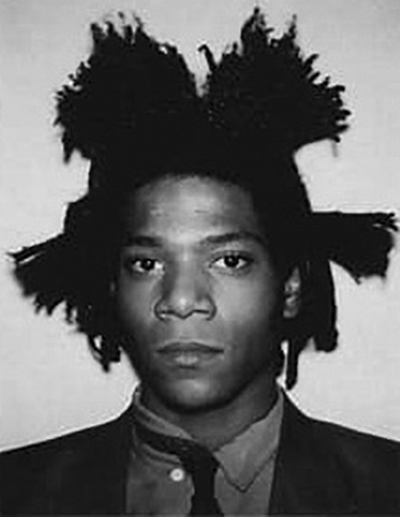JEAN-MICHEL BASQUIAT (1960-1988)
 Jean-Michel Basquiat was an American artist. He began as an obscure graffiti artist in New York City in the late 1970s and evolved into an acclaimed Neo-expressionist and Primitivist painter by the 1980s. Throughout his career Basquiat focused on “suggestive dichotomies,” such as wealth versus poverty, integration versus segregation, and inner versus outer experience. Basquiat’s art utilized a synergy of appropriation, poetry, drawing and painting, which married text and image, abstraction and figuration, and historical information mixed with contemporary critique. Utilizing social commentary, Basquiat’s paintings also attacked power structures and systems of racism, while his poetics were acutely political and direct in their criticism of colonialism and support for class warfare.
Jean-Michel Basquiat was an American artist. He began as an obscure graffiti artist in New York City in the late 1970s and evolved into an acclaimed Neo-expressionist and Primitivist painter by the 1980s. Throughout his career Basquiat focused on “suggestive dichotomies,” such as wealth versus poverty, integration versus segregation, and inner versus outer experience. Basquiat’s art utilized a synergy of appropriation, poetry, drawing and painting, which married text and image, abstraction and figuration, and historical information mixed with contemporary critique. Utilizing social commentary, Basquiat’s paintings also attacked power structures and systems of racism, while his poetics were acutely political and direct in their criticism of colonialism and support for class warfare.
As a graffiti artist, Basquiat often incorporated words into his paintings. Before his career as a painter began, he produced punk-inspired postcards for sale on the street, and became known for the political–poetical graffiti under the name of SAMO. The conjunction of various media is an integral element of Basquiat’s art. His paintings are typically covered with text and codes of all kinds: words, letters, numerals, pictograms, logos, map symbols, diagrams and more. A middle period from late 1982 to 1985 featured multipanel paintings and individual canvases with exposed stretcher bars, the surface dense with writing, collage and imagery. The years 1984-85 were also the main period of the Basquiat–Warhol collaborations, even if, in general, they weren’t very well received by the critics. Basquiat doodled often and some of his later pieces exhibited this; they were often colored pencil on paper with a loose, spontaneous, and dirty style much like his paintings. His work across all mediums display a child-like fascination with the process of creating.
